If you’re considering moving to Japan, be ready to get on board the major first mission. I didn’t have to do too much for moving to Italy and Malawi, for having found good places to live in before arriving. But moving to Japan was different because my company let us live in the dormitory while finding by ourselves a place that fits our taste. So here’s my advice based on experience. Not saying these are the only options, though. 🙂
First, start with finding an agency that speaks English. It was tempting to contact the numbers on the vacancy adverts on exquisite buildings, but most of those “common” real estate agencies only provide services in Japanese. So if you speak sukoshi Japanese or none at all (like me when I arrived), choosing English-speaking agency is wise. I found UR Whitestone, UR Sumai, and LeoPalace21. There are many other English-speaking agencies in big cities like Tokyo and Osaka (easy to google them), but they usually manage upscale apartments. If you’re on a solo mission, it’s not really worth your time and energy to contact non-English speaking agents. Trying to understand is tiring and risky, and you wouldn’t want to depend on someone’s help for all the conversation.
Say you got that anglophone buddy. Start off in the following order:
1. Decide where you want to live.
Sounds like a given, but it’s not. Of course the city and area nearest to your work/study place is the best. But in my case, I work in a small town where only rich senior people live. Not really my crowd. The closest (slightly) bigger town is a beach town packed in summer, but with nothing to do in the rest of the year. So I looked at other areas. I finally chose an area about 45 minutes from work (but that includes 30 minutes bus ride from the train station to office).
Worry not about long commute. One of the best things about Japan is its well-connected, reliable, comfortable transport system. Well the stories about packed subways and trains in Tokyo and the “pusher” (train company officers pushing people to fit into crowded cars) are no hoax, but that’s Tokyo. In the capital, it might be better to live as close as possible to your office or school. In my case, in Kanagawa, transferring between train lines is easy and even buses are crazily on time. Coming from Jakarta, where I used to commute 4-hours traffic-jammed round trips every day (it was my choice to live in the suburbs), easy commute between neighboring cities in Kanagawa is more than I could ask for.
Identify the train lines and stations that connects you to your daily destination and decide how far from the home station you want to live. Usually agencies define their apartment location based on ‘minutes’ to take to the nearest transport hub (“5 minutes (分) to the X train station”, “1 minute to a bus stop from where you can take a bus for 8 minutes to Y train station”, etc.) Also consider how your company supports your commuting cost. Japanese companies usually pay for it.
2. Choose accommodation type. Generally, there are three types of housing for single young people: regular apartment, UR apartment, short-term apartment, and share-house.
I’m gonna tell you the most important thing about apartments: no matter which agency, most apartments come unfurnished. Most of them have no more than a toilet, a kitchen cabinet, and a wardrobe. Sometimes you can get a set of stove and/or air conditioner. So you’ll need initial cost and time to find refrigerator, sofa, bed, tables, etc.
Regular apartments are rented out by landlord/owners through real estate agencies. It’s very common to see advertisements on the street, especially near train stations. Some big agencies website: www.able.co.jp , www.minimini.jp, www.chintai.net. Like I mentioned, however, expect to spend extra energy in communicating.
Plus side: wide range of apartments to choose from, nice building and interior design. Most are small as some people prefer. It’s easy to get car parking space if you need it (although expensive, it goes between JPY 12,000-35,000/month in Greater Tokyo, depends on the area).
Downside: most agencies and landlords ask for ridiculous amount of initial cost. There’s “key money” (it’s widely known as “money for thanking the landlord to allow your living in his/her property” :p, amount varies, you won’t get it back), “agency fee” (agency service fee, amount varies, of course you won’t get it back), “deposit” (amounts to 2-3 months’ rent, some of it will be returned when you leave the apartment, after some deduction for cleaning and repair fee). Lastly, “contract renewal fee”. Say, you have a one-year contract. After one year, if you want to stay longer, you have to pay for staying longer (amount varies, you won’t get it back either).
All in all, you can easily be asked to give up to 4, or even 6-months worth of rent. Although if you have time and patience, some agents don’t ask that much for some apartments. But I didn’t consider it further.
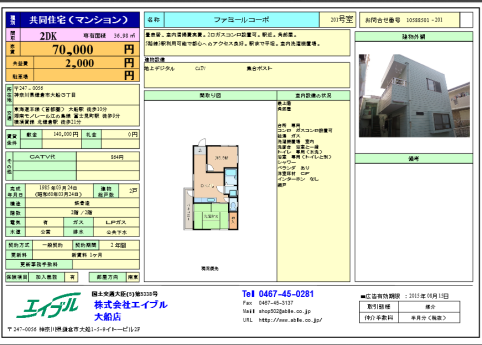 A sample of apartment details from a regular agency. Too much kanji for a day.
A sample of apartment details from a regular agency. Too much kanji for a day.
And then there’s UR (Urban Renaissance) apartment (jyuutaku, じゅうたく, 住宅) government-owned property marketed by several partnering agencies. You can look for the apartments first (based on location, train station, etc.) through their website ur-housing.com (Whitestone, I used their service), sumai.ur-net.go.jp, then email them to ask the availability. These agencies, thankfully, speak English.
Plus side: the initial cost for UR apartments is only a 2-3 months deposit (most of it will be returned when you leave apartment, after some deduction for cleaning and small repairs) and the rent for the amount of days in the month you are moving in. You can easily move in and out, with a 2-weeks notice.
Downside: many buildings are old and mostly high-rise (some people don’t prefer them). Some people might think it’s “cheap” and for “the cheap” for its affordability. But it’s getting more popular because the management has been renovating and maintaining the buildings well. There are even gorgeous apartments designed in collaboration with MUJI or IKEA. It’s difficult to get a furnished (stove and air conditioning-equipped) apartment in a good location. But you can use that money to buy furniture and appliances instead of paying administrative cost.
Share-house is for you who wants instant new friends and to immerse in a multicultural atmosphere and doesn’t mind less privacy. In Japan, share-houses mean huge buildings with 20-50 inhabitants with small rooms rented out for 1-2 persons each. In some cases you can find a smaller house, where 10-15 people live, and in rare cases, only 5-6 people. Tokyo Sharehouse and Hituji are good websites to find these houses.
Plus side: Meet people and make friends overnight. People from different backgrounds and characters. Dinner and welcome parties are held occasionally. In-house laundry, internet service, sometimes bicycle. Some houses provide cleaning service for your rooms, aside from cleaning the common areas. Kitchens and common areas are big and well-equipped. Really less hassle.
Downside: No privacy. People come and go, not only residents but also their friends so it will get noisy. Less sense of propriety including in the kitchen. The rooms are small (can go down to 6 m2), usually comes with a bed and a wardrobe. Some rooms are dormitory type. The amount of bathroom (and whether you’ll need to queue every morning) depends on your luck. Not all people are clean or tidy. Most houses don’t allow sleepovers (or ask you to ask permission to the manager first, and Japanese rules are not made to be broken).
I saw a small 4-room share-house in Zushi and I liked it, the other girls living there were a calligraphist, a yoga student, and a waitress. But I decided not to choose share-house, choosing privacy and my own space over making friends overnight. So old school? :p A colleague assured me that I’ll meet and make friends through other ways. Also, I want to be able to host dinners, gatherings, friends, family, or Couchsurfers at home. I do feel, sometimes, that it would be nice to live with people. But people who are sharing houses are telling me they are planning to move to their own places, more than those who are saying otherwise.
Short-term furnished apartments is a category I made. I was informed about Leopalace21 agency before coming to Japan, and I was interested because they have furnished apartments. They offer monthly and even daily contracts for people who often visit Japan for short trips. You can save money on hotels and have a private space with equipped kitchens and television.
Plus side: no need to buy kitchen appliances because they provide stove, refrigerator, and microwave. They help installing services like TV and internet (at above types of apartments you need to set these up on your own). If you’re in Japan for a short-term, like a few months, but need a private space, I think this is for you.
Downside: initial cost is quite expensive, although not as expensive as regular apartments. A lot of people are staying for a short-term, so some of them can be quite careless. I heard and read some reviews about many of its buildings being a bit poor in soundproofing.
3. Say you decide to get an apartment. You’ll then have to choose layout and size.
The Japanese system is based on the number of bedrooms and room functions. The number represents the amount of bedroom(s) and the letters represent the functions which can be provided by the other room(s). For example:
2 DK : 2 bedrooms, plus another room big enough to be a dining room (D) and kitchen (K).
1 LDK : 1 bedroom, plus another room big enough to be a living room (L), dining room (D), and kitchen (K).
1 K : 1 bedroom, plus another room big enough only for a kitchen (this means your bedroom will also be used as a living room and dining room). This is the most common layout for single people especially in crowded cities like Tokyo. Most Leopalace21 apartments are 1K.
1 R : only 1 room (everything done here). This is a small “studio” type apartment.
The size of apartments are in square meter or sometimes in “tatami size”. Tatami is the grass mat you frequently see on anime or Japanese TV shows, on which families kneel and eat dinner together, which comes in panels of about 6 m2 each.
I don’t think I’ll surprise anyone by saying affordable apartments in Tokyo are generally small. Yes, those inhumane ‘shoe-boxes’ are real. So don’t be surprised to see a small, around 10 m2 apartments, that costs JPY 55,000 (about USD 500) a month. Land is luxury in To-ki-o.
So, what did I do?
I first tried LeoPalace. Their agent spoke excellent English and I saw two nice places in Totsuka and Ofuna but they were too far of walk from the station, plus the initial cost was too high for me.
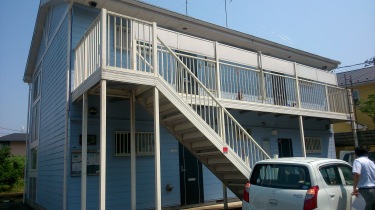 LeoPalace21 apartment in Ofuna
LeoPalace21 apartment in Ofuna
 Living room of LeoPalace21 apartment in Totsuka
Living room of LeoPalace21 apartment in Totsuka
I also was in a short contact with an able (アベル) agent who didn’t speak or write English. Our relationship didn’t last very long. I finally settled with UR Whitestone agency, and after three attempts, settled in an apartment in Sakae-ku, Yokohama, near Kamakura (suburbs, but technically still in Yokohama :p), on the top floor of a high-rise building just 5 minutes walk from the station. A gorgeous, newly renovated, wood-floored 1LDK unit in gray and white palette. In autumn and special occasions like New Year, the municipality organize fairs and festivals. Quite the perfect place really. 🙂
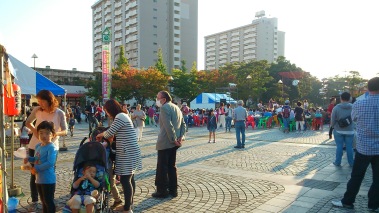 That’s my apartment in the background of autumn dance festival!
That’s my apartment in the background of autumn dance festival!
After choosing the apartment, I had to go with my agent to the UR office to sign contracts and pay the initial amount. The initial cost was only 2 months deposit and the rent for the first days (this is the best I could get, and the best you can ever get, I heard). I spent almost 2 months to look for a home. It wasn’t easy. I felt like accomplishing one big mission when I finally moved in. Of course, it was empty. I slowly furnished my apartment from getting a refrigerator to a sofa, which was another process of careful considerations and calculations. I’ll save that for later.
Edit: my post on filling up the apartment is here: https://amellina.me/2018/02/04/living-japan-6-mission-apartment-part-two
How was your experience in finding apartments in Japan? Or other countries? Do you have any questions? Leave your comments! 🙂

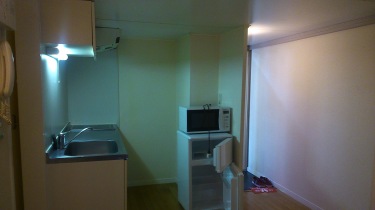
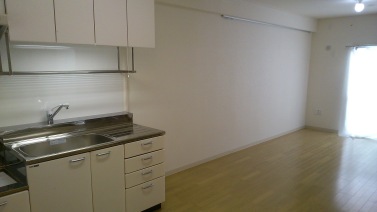
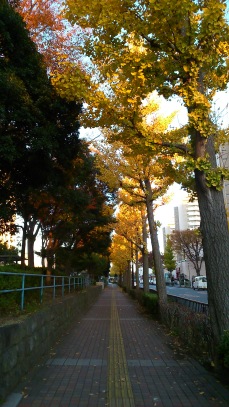
Great article everyone wanting to move to Japan should read. I took the easy route many years ago and found a room for rent on Craigslist. It was a cool experience, although I’m a man so taking those risks is a bit easier.
LikeLiked by 1 person
Thanks pheyton! Craigslist seems a bit dodgy for me LOL :p How was that “cool” experience like?
LikeLike
Yes, I know it would be dodgy for a lot of people.
It was a wild experience. My roommate was somewhat of an old American talent, but she was aging and things were becoming difficult for her. She occasional took met out to parties and had interesting friends over.
The house was very old, two story, but that was fantastic for me. I loved the tiny staircase, the creek of the floor boards etc. it really felt like living in Japan. Oh, and she had a pet monkey who could be a real bastard. Think he didn’t like another male in the house. Only in Japan!
LikeLiked by 1 person
An eccentric woman with a pet monkey?? Really something you could get out of craigslist LOL. Sounds like a wicked time with plenty of memory. It’s a pity sharing an apartment isn’t too popular here. Which city did you live in? From the features of the house and keeping a jealous monkey well around, I’m thinking someplace like Nagano or somewhere far west 😉
LikeLike
Ha ha, nope it was Tokyo, in between Shinjuku and Ikebukuro. The house was definitely the last of it’s kind. Not even sure if it’s still there.
LikeLike
That was unexpected! Should keep an eye out for monkeys next time I walk around that area, hahaha.
LikeLike
Reblogged this on Ya? Apa? and commented:
Catatan tentang mencari tempat di Jepang oleh Aryanie Amelia
LikeLike